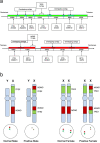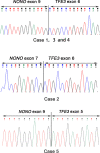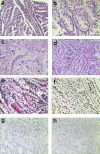The suitability of NONO-TFE3 dual-fusion FISH assay as a diagnostic tool for NONO-TFE3 renal cell carcinoma
- PMID: 33004995
- PMCID: PMC7530984
- DOI: 10.1038/s41598-020-73309-4
The suitability of NONO-TFE3 dual-fusion FISH assay as a diagnostic tool for NONO-TFE3 renal cell carcinoma
Abstract
NONO-TFE3 RCC is a subtype of Xp11.2 translocation renal cell carcinoma (RCC). So far, only a small amount of NONO-TFE3 RCC have been reported owing to lack of effective diagnosis methods. Utilizing the novel dual-fusion fluorescence in situ hybridization (FISH) probe reported here, 5 cases of NONO-TFE3 RCC were identified and were ultimately confirmed by RT-PCR. Histopathology, all 5 cases were consisted by sheets of epithelial cells and papillary architecture. The cytoplasm was abundantly clear, and nucleoli was not prominent. Besides, the nuclear palisading, subnuclear vacuoles and psammoma bodies were identified. The most distinctive features were strong positive TFE3 staining but equivocal split signals of the TFE3 probe, which might lead to the misdiagnosis of Xp11.2 translocation RCC. The median age and median tumor size of the five patients were 41.2 years and 3.6 cm, respectively. A median following follow-up of 27 months showed moderate disease progression and prognosis in NONO-TFE3 RCC patients. In conclusion, the present study demonstrates the effectiveness and reliability of the NONO-TFE3 dual-fusion FISH probe for diagnosing NONO-TFE3 RCC. Suspected cases of Xp11.2 translocation RCC showing biphasic pattern, strong positive TFE3 staining, and equivocal split signals in the TFE3 FISH assay indicated a possibility of NONO-TFE3 RCC.
Conflict of interest statement
The authors declare no competing interests.
Figures







Similar articles
-
[Clinicopatholigic features of renal cell carcinoma associated with chromosome X inversion harboring gene fusions involving TFE3].Zhonghua Bing Li Xue Za Zhi. 2018 Aug 8;47(8):574-579. doi: 10.3760/cma.j.issn.0529-5807.2018.08.002. Zhonghua Bing Li Xue Za Zhi. 2018. PMID: 30107660 Chinese.
-
Xp11.2 translocation renal cell carcinoma with NONO-TFE3 gene fusion: morphology, prognosis, and potential pitfall in detecting TFE3 gene rearrangement.Mod Pathol. 2017 Mar;30(3):416-426. doi: 10.1038/modpathol.2016.204. Epub 2016 Dec 9. Mod Pathol. 2017. PMID: 27934879
-
TFE3-Fusion Variant Analysis Defines Specific Clinicopathologic Associations Among Xp11 Translocation Cancers.Am J Surg Pathol. 2016 Jun;40(6):723-37. doi: 10.1097/PAS.0000000000000631. Am J Surg Pathol. 2016. PMID: 26975036 Free PMC article.
-
RBM10-TFE3 renal cell carcinoma characterised by paracentric inversion with consistent closely split signals in break-apart fluorescence in-situ hybridisation: study of 10 cases and a literature review.Histopathology. 2019 Aug;75(2):254-265. doi: 10.1111/his.13866. Epub 2019 Jun 25. Histopathology. 2019. PMID: 30908700 Review.
-
[The translocation carcinoma: A pediatric renal tumor also in adults].Pathologe. 2016 Mar;37(2):159-65. doi: 10.1007/s00292-016-0151-2. Pathologe. 2016. PMID: 26972595 Review. German.
Cited by
-
Clinicopathological features and prognosis of TFE3-positive renal cell carcinoma.Front Oncol. 2022 Oct 6;12:1017425. doi: 10.3389/fonc.2022.1017425. eCollection 2022. Front Oncol. 2022. PMID: 36276115 Free PMC article.
-
MiT/TFE Family Renal Cell Carcinoma.Genes (Basel). 2023 Jan 5;14(1):151. doi: 10.3390/genes14010151. Genes (Basel). 2023. PMID: 36672892 Free PMC article. Review.
References
-
- Wang XT, Xia QY, Zhou XJ, Rao Q. Xp11 Translocation renal cell carcinoma and the mesenchymal counterparts: an evolving concept with novel insights on clinicopathologic features, prognosis, treatment, and classification. Crit. Rev. Oncog. 2017;22:481–497. doi: 10.1615/CritRevOncog.2017020558. - DOI - PubMed
Publication types
MeSH terms
Substances
LinkOut - more resources
Full Text Sources
Medical

